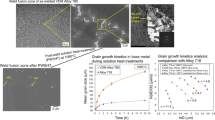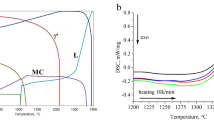Abstract
Mechanical alloying has been applied to produce a dispersion-strengthened superalloy IN-738 containing 1.5 wt pct Y2O3. Annealing of extrusion bars above the recrystallization temperature of 1160°C can be described by three stages of recrystallization:finegrain; isotropic coarse-grain; and fibrous coarse grain growth. A maximum grain length of 550 μm and a maximum grain aspect ratio of 4.8 have been obtained for an alloy, which had been extruded at 1100°C and annealed at 1280°C and 1270°C for 3 h, respectively. The three stages of grain growth are explained in terms of recovery, differences in nucleation rate and dispersoid concentration in the two normal directions and release in stored cold work. Secondary recrystallization can be excluded as a mechanism for fibrous grain coarsening. Dispersion-strengthened IN-738, heat treated to a coarse elongated grain structure, has both high intermediate temperature strength and high elevated temperature strength. The creep strength at 1000°C exceeds that of cast or directionally solidified IN-738 after 300 h service life. The failure mechanism at elevated temperature is intergranular fracture along transverse grain boundaries, nucleated by cavities that form during grain boundary sliding. Nucleation of voids is retarded in the creep specimens due to diffusional accommodation of grain boundary sliding. A depletion of surface zones of chromium, aluminum and titanium contributes to initiation of creep failure at 1000°C.
Similar content being viewed by others
References
J. S. Benjamin:Met. Trans., 1970, vol. 1, p. 2943.
J. S. Benjamin and T. E. Volin:Met. Trans., 1974, vol. 5, p. 1929.
B. A. Wilcox and A. H. Clauer:Acta Met., 1972, vol. 20, p. 743.
Nickel-Base, Vacuum-Cast, Hith Temperature Alloy IN-738, Technical data sheet, International Nickel Ltd., Thames House Millbank, London, Sept. 1968.
High Temperature, High Strength Nickel-Base Alloys, The International Nickel Company, Inc., 67 Wall street, New York, N.Y. 10005, June 1968.
R. L. Cairns:Met. Trans., 1974, vol. 5, p. 1677.
P. R. Mould and P. Cotterill:J. Mater. Sci., 1967, vol. 2, p. 241.
T. E. Dunham:Met. Trans., 1971, vol. 2, p. 2797.
R. V. Miners:NASA TM X-2545, April 1972.
R. L. Cairns, L. R. Curwick, and J. S. Benjamin:Met. Trans. A, 1975, vol. 6A, p. 179.
T. E. Dunham and R. L. Daga:Met. Trans., 1973, vol. 4, p. 175.
K. C. Thompson-Russel and Ch. Prozee:(Philips, Marheeze (Netherlands))Development of Deformation Texture and Nucleation of Recrystallisation in Heavily Deformed Drawn Tungsten Wire, paper presented at the 4th Euro- pean Conference on Textures in Metals, Cambridge, England, July 1975.
D. A. Woodford and J. J. Frawley:Met. Trans., 1974, vol. 5, p. 2005.
J. D. Whittenberger:NASA TN D-7079, 1972.
Author information
Authors and Affiliations
Rights and permissions
About this article
Cite this article
Gessinger, G.H. Mechanical alloying of IN-738. Metall Trans A 7, 1203–1209 (1976). https://doi.org/10.1007/BF02656604
Received:
Issue Date:
DOI: https://doi.org/10.1007/BF02656604




